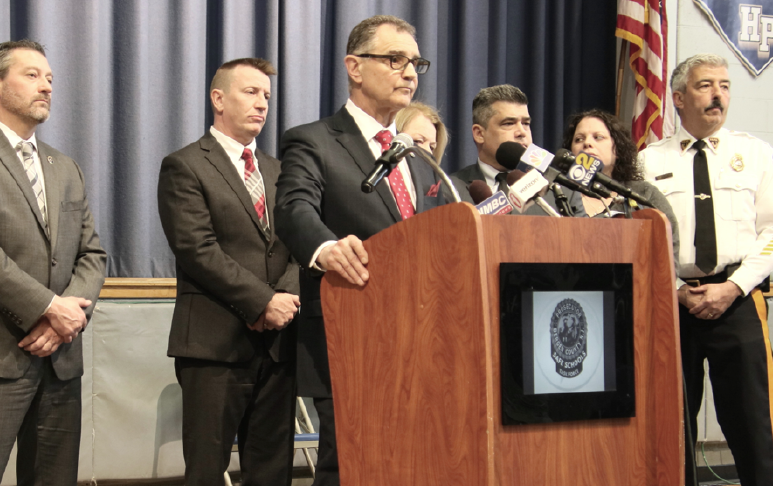
BERGEN COUNTY, N.J.—If a student’s mental health was considered right along with physical health, it would make a whole lot of sense.
That’s one goal worth striving for, said Freeholder Mary Amoroso, chair of the county Prosecutor’s Office Safe Schools Task Force committee on legislation and policy.
That committee has focused efforts on student mental and emotional health, as well as legislative and funding options, to enhance school safety and security over the last nine months.
Maybe one day, Amoroso said, mental health check-ups will be as routine as the medical check-ups required for students to participate in sports—although many concerns remain to be worked out regarding privacy and confidentiality of such check-ups, she added.
Moreover, said Amoroso, more available mental health check-ups would be one more tool to be proactive and identify areas of mental health concern or warning signs early on that could be addressed before a larger problem develops.
Of course, Amoroso said, much work remains to be done on mental health in schools, but its role is more prominent now than ever before in the minds of school, law enforcement, and mental health professionals, plus state legislators, municipal officials and the governor.
“I really think that since [students] get physicals done for playing sports, I wish that there were some way for schools to offer mental health check-ups” for students experiencing mental stress, she said.
Stressors may include a student being troubled, a student being bullied, or a student facing academic or social challenges, Amoroso said.
A psychologist on call
One likely recommendation from the Safe Schools Task Force January 2020 report is a call for school psychologists and full-time assessment care teams in every school, said Amie DelSordo, task force mental health committee chair.
Assessment Care Teams include a principal or vice principal, mental health professional and school safety personnel.
Such a team can make informed decisions about students identified as possible threats to themselves or others, and should be mandatory, said the task force mental health committee.
Mental-health training has taken place for educators over the last year to identify “warning signs” and the committee plans to expand its training to students and parents in 2020, said DelSordo.
DelSordo said 1,337 school staff and 63 schools have received mental health training in 2019 to help them identify possible signs of trouble and how to connect at-risk students with resources.
Possible funding next year may come from about $300 million dedicated to school security in a 2018 Securing Our Children’s Future Bond Act, which was approved by voters, said Amoroso.
Grant funding guidelines for school security projects are anticipated in spring 2020, said Gov. Murphy recently.
“Mental health education is very important, and we really need to beef up our education and understanding in these areas,” Amoroso said.
She said one of the biggest challenges now is “pulling together all the information and efforts that are out there and letting people know about them.”
Amoroso cited two recent “innovative” mental health initiatives begun in Fort Lee school district and at Park Ridge High School, presented Oct. 29 at the Prosecutor’s Office SNAP conference.
Amoroso said a new law requiring mental health education in grades K-12 beginning in September 2020 statewide was signed by Gov. Phil Murphy in August.
She said the new law will put mental health on par with other topics discussed in the classroom.
“The requirements are now in place to ensure mental health [concerns] are incorporated,” said Amoroso.
She noted the state education department will review and update learning standards to include an age-appropriate mental health curriculum for the 2020-2021 school year.
“A school district shall ensure that its health education programs for students in grades kindergarten through 12 recognize the multiple dimensions of health by including mental health and the relation of physical and mental health so as to enhance student understanding, attitudes, and behaviors that promote health, well-being, and human dignity,” states the law approved by Murphy on Aug. 9.
“The instruction in mental health shall be adapted to the age and understanding of the students and shall be incorporated as part of the district’s implementation of the New Jersey Student Learning Standards in Comprehensive Health and Physical Education. The instruction shall include, as appropriate, information on substance abuse provided pursuant to the implementation of these standards,” reads the law.
‘Early intervention’
In late 2018, the state School Boards’ Association—alarmed at the increasing number of school shootings nationwide and rising suicide rate—formed a task force to “study the impact of the effective delivery of mental health services and early intervention strategies on student health and wellness, school climate, and school security.”
The task force was composed of local school board members, superintendents and mental health experts and issued its final report, including 71 recommendations, in mid-October.
The report addressed a diversity of factors affecting students’ mental-health: social-emotional learning, crisis response, school climate, community outreach, and equity.
“Mental health can be challenging, especially for students who are undergoing massive changes in their bodies and their lives without the necessary understanding or experience to handle the pressures they are facing. The task force did not want to focus solely on suicide and school shootings, though these are the most alarming and visible outgrowths of mental health issues. The problem, experts say, is much broader, deeper—and closer to home—than the most horrific outcomes,” said the report’s executive summary.
“The serious emotional trouble that students are experiencing evidences itself in disturbing ways. Students are self-mutilating or cutting themselves at a higher rate than ever before. According to Mental Health America, approximately 15% of teens are reporting some form of self-injury. For students between the ages of 13 and 18, 20% live with a mental health disorder, according to the National Alliance on Mental Illness (NAMI),” notes the report.
Mental health ‘essential’
“If the central mission of New Jersey public schools is to provide a “thorough and efficient education,” preparing students for college, career and success in life, then it is essential that schools address the mental health of their students—and the teachers and staff who work with them. By ignoring their mental health, we are limiting our students’ future promise. Nationwide, 37 percent of students with a mental health condition age 14 and older drop out of high school, according to NAMI—the highest dropout rate of any disability group,” adds the report summary.
Based on studies and data, the report reached four conclusions:
1) Young people’s access to mental health services is very limited;
2) No school is suicide-proof;
3) School officials cannot address the mental-health situation alone; and
4) Trust among students and staff is essential for a safe and healthy school climate.
Almost 300 suicides in 3 years
The report noted among youth ages 8 to 15 with diagnosed mental illnesses, approximately half do not receive mental health services.
In addition, the state Department of Children and Families reports that 2,731 young people, ages 10-24, were treated in hospital emergency rooms for attempted suicide or self-inflicted injuries in 2013 through 2015; in the same age group, 283 suicides occurred.
In addition, collaboration between law enforcement, school officials, local government and community organizations is essential to ensure school safety.
Another factor is trust among students and staff to help head off potential trouble.
“For example, in four out of five school shootings, at least one other person had knowledge of the attacker’s plan but failed to report it,” according to Sandy Hook Promise, a national nonprofit organization.
“Not only does this statistic illustrate the need for anonymous tip lines but, equally significant, it necessitates programs and procedures that ensure that each student has a trusting relationship with at least one adult in the school,” states the report.
‘LiveSafe’ tip app
In Bergen County, the county Prosecutor’s Office recently initiated a cell phone app called LiveSafe, which can be downloaded onto a student’s or parent’s phone to enable them to provide anonymous tips to a county police dispatcher, who will then relay the tip or communication to an appropriate authority or resource for follow-up.
The LiveSafe app enables anonymous, streamlined communication to the Bergen County emergency services dispatch center in case of a school shooting incident, or to alert authorities or mental health professionals to situations posing risk. These may include threatening behavior, suspicious activity, bullying, illegal drug use or activity, or students in need of intervention or counseling, said county officials.
The county Prosecutor’s Office rolled out the LiveSafe app this fall and urged students and parents to participate.
“LiveSafe is a simple and user-friendly platform targeted to our Bergen County student population—those most likely to have crucial information needed to prevent school violence,” noted the prosecutor’s task force report.

